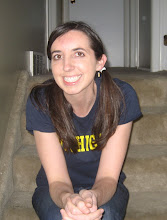[I foresee five types of posts on the math blog: (1) games and activities to do with young children, (2) reviews of children's mathematics books with suggestions about how to engage children in the mathematics, (3) principles and guidelines for interacting with young children about mathematics, (4) descriptions of mathematical concepts that children are engaging in, and (5) accessible summaries of research about young children and mathematics. The following post is of the second type.]
Zero, by Kathryn Otoshi (Book Review)
I’m much more partial to the subtler side of the continuum, where the author weaves math into the fabric of the story, rather than fitting a story onto the math. It’s not that I think kids will only swallow the math if we sneak it into their literary diet. There are some fantastic, mathiest-of-math books that are engaging and fun and fantastic for children. But sometimes when the mathematics doesn’t jump out and hit you on the head there can be a lot more room for conversation. You just need to know what to look for.
One of my students recently lent me her copy of Kathryn Otoshi’s Zero. I had neither seen nor heard of this book, but I fell in love with it from the very first page. This book hits my sweet spot—simple, gorgeous illustrations; an engaging, child-friendly story; solid mathematics; and plenty of conversation fodder. It’s fantastic. I’m going to give it to myself for Christmas.
In this book, there are two big mathematical ideas:
- Zero is a different kind of number. I could write a whole blog post about this idea. (I probably will.) But here’s the short of it: young children don’t initially think of zero as a number because zero is not “part of the count.” When we count, we typically start with “one”. And we never ask our children to count a set of no objects. They’d probably think we were joking if we pointed at an empty tabletop and said, “Count the M&Ms!”
- With only ten symbols, we are able to write numbers as big as we want to. This is an under-recognized beauty of our number system. Many historical number systems (like Roman numerals) can only represent quantities up to a certain size before running out of symbols. But our modern Arabic numerals have infinite possibilities for combining just ten symbols into any number we can imagine.
So what can you do with this book (besides read it)? Talk about the math! Here are just a few ideas to get you started, but let your child lead the way and see where the conversation takes you.
- Ask your child, “Is zero a number?” and see what they say. Probe their thinking. You can use the context of the book (but you don’t have to). Why would zero feel left out? What’s different about zero?
- Have your child write the biggest number they can think of, and the smallest number they can think of. Together, see if you can think of bigger and bigger numbers (and for older children, smaller and smaller). It’s a game, but a game that can help your child think about how writing numbers “works.”
- Talk about how the numbers in the book can join themselves together. What kinds of numbers could two numbers make? Four numbers?
- And you don’t have to stop at math. Talk about friendships, fitting in, being yourself, working together.







3 comments:
I love this! There are a million mommy blogs out there, but I've never seen one touching this subject matter. Very refreshing and very informative. The only suggestion I might offer is, I realize all children are at different levels, but perhaps suggest an age range that the book or activity are geared toward. And, I would love ideas for older children, particularly as a summer bridge for the elementary grade levels?
Well now I want to find this book! I never really thought about zero until I heard the song "Zeros" by They Might be Giants https://www.youtube.com/watch?v=L8pySVYytRs which helped me to realize "zeros mean so much".
Have you ever read The Smushy Bus by Leslie Helakoski? Yes, it is a more obvious math-y book, but it's one that I discovered. It was fun to notice how math concepts were used and it's full of math puns.
Emily is right-this seems like a unique blog subject. Keep them coming!
As unique as everyone says your blog is, I have been thinking of the same kind of blog! I think it's a great idea. I haven't taught math for over 5 years and really want to do something. I have been tutoring some and I do all I can for my preschooler but have found myself searching for ways to use my education and my teaching background even though I'm not "working" at the moment. I would love to read your blog and learn more. I am currently on the search for books or articles so that I can keep up on things. Because I have young children, I am really interested in early math education. If you have any recommendations for me for things to read, let me know. And congratulations on your little boy! He is adorable!
~Danielle (Gigger) Carter
Post a Comment